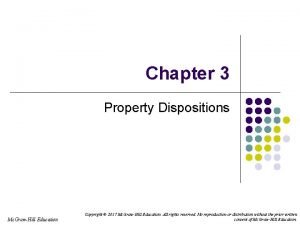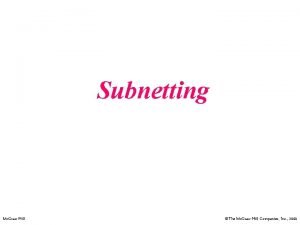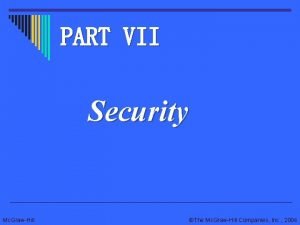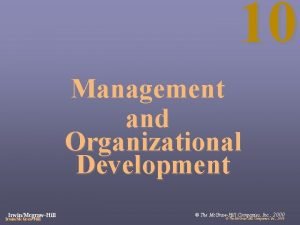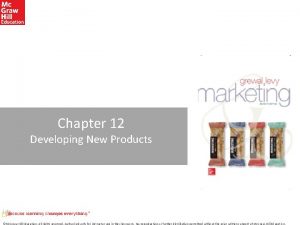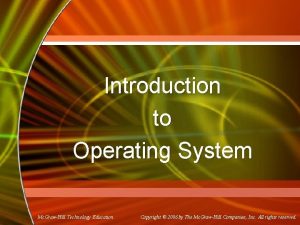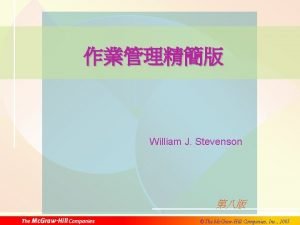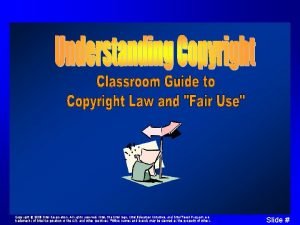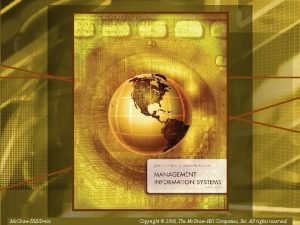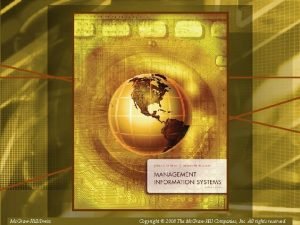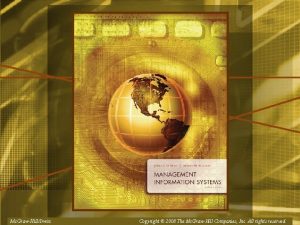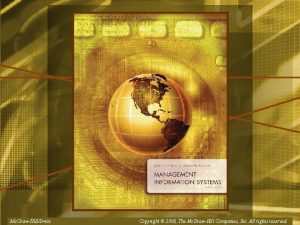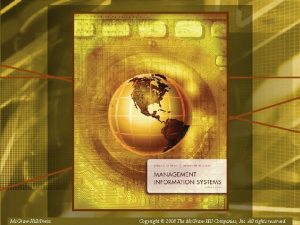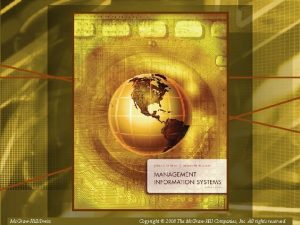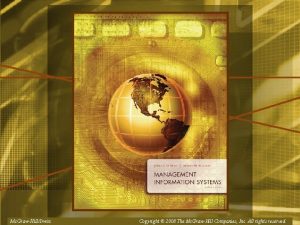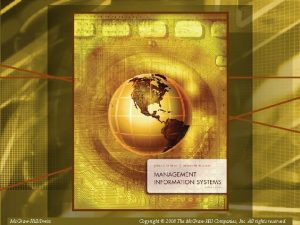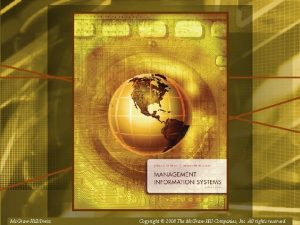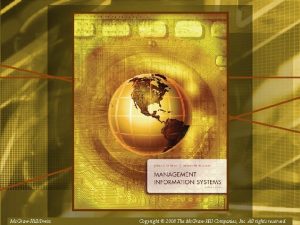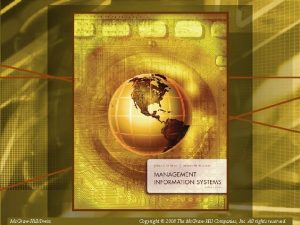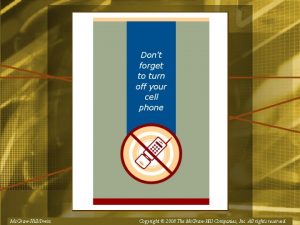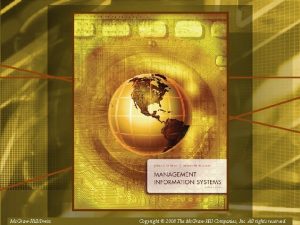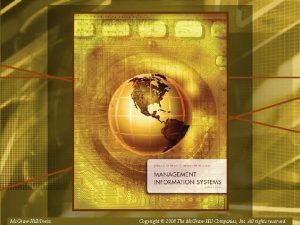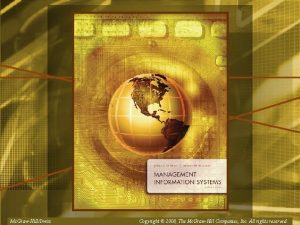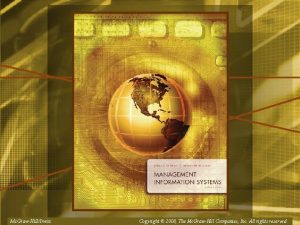Mc GrawHillIrwin Copyright 2008 The Mc GrawHill Companies







































- Slides: 39

Mc. Graw-Hill/Irwin Copyright © 2008, The. Mc. Graw-Hill. Companies, Inc. Allrightsreserved.

Chapter 1 Foundations of Information Systems in Business Mc. Graw-Hill/Irwin Copyright © 2008, The. Mc. Graw-Hill. Companies, Inc. Allrightsreserved.

Foundation Concepts • Why study information systems and information technology? • Vital component of successful businesses • Helps businesses expand compete • Improves efficiency and effectiveness of business processes • Facilitates managerial decision making and workgroup collaboration 3

What is a System? • • A set of interrelated components With a clearly defined boundary Working together To achieve a common set of objectives 4

What is an Information System? • An organized combination of… • • • People Hardware and software Communication networks Data resources Policies and procedures • This system… • Stores, retrieves, transforms, and disseminates information in an organization 5

Information Technologies • Information Systems • All the components and resources necessary to deliver information and functions to the organization • Could be paper based • Information Technologies • Hardware, software, networking, data management • Our focus will be on computer-based information systems (CBIS) 6

What Should Business Professionals Know? 7

Fundamental Roles of IS in Business 8

Trends in Information Systems 9

What is E-Business? • Using Internet technologies to empower… • • Business processes Electronic commerce Collaboration within a company Collaboration with customers, suppliers, and other business stakeholders • In essence, an online exchange of value 10

How E-Business is Being Used 11

E-Business Use • Reengineering • Internal business processes • Enterprise collaboration systems • Support communications, coordination and coordination among teams and work groups • Electronic commerce • Buying, selling, marketing, and servicing of products and services over networks 12

Types of Information Systems • Operations Support Systems • • Efficiently process business transactions Control industrial processes Support communication and collaboration Update corporate databases • Management Support Systems • Provide information as reports and displays • Give direct computer support to managers during decision-making 13

Purposes of Information Systems 14

Operations Support Systems • What do they do? • • Efficiently process business transactions Control industrial processes Support communications and collaboration Update corporate databases 15

Types of Operations Support Systems • Transaction Processing Systems • Record and process business transactions • Examples: sales processing, inventory systems, accounting systems • Process Control Systems • Monitor and control physical processes • Example: using sensors to monitor chemical processes in a petroleum refinery • Enterprise Collaboration Systems • Enhance team and workgroup communication • Examples: email, video conferencing 16

Two Ways to Process Transactions • Batch Processing • Accumulate transactions over time and process periodically • Example: a bank processes all checks received in a batch at night • Online Processing • Process transactions immediately • Example: a bank processes an ATM withdrawal immediately 17

Management Support Systems • What do they do? • Provide information and support for effective decision making by managers • Management information systems • Decision support systems • Executive information systems 18

Types of Management Support Systems • Management Information Systems (MIS) • Reports and displays • Example: daily sales analysis reports • Decision Support Systems (DSS) • Interactive and ad hoc support • Example: a what-if analysis to determine where to spend advertising dollars • Executive Information Systems (EIS) • Critical information for executives and managers • Example: easy access to actions of competitors 19

Other Information Systems • Expert Systems • Provide expert advice • Example: credit application advisor • Knowledge Management Systems • Support creation, organization, and dissemination of business knowledge throughout company • Example: intranet access to best business practices 20

Other Information Systems • Strategic Information Systems • Help get a strategic advantage over customer • Examples: shipment tracking, e-commerce Web systems • Functional Business Systems • Focus on operational and managerial applications of basic business functions • Examples: accounting, finance, or marketing 21

Measuring IT Success • Efficiency • Minimize cost, time, and use of information resources • Effectiveness • • Support business strategies Enable business processes Enhance organizational structure and culture Increase customer and business value 22

Developing IS Solutions 23

Challenges and Ethics of IT • Application of IT • Customer relationship management • Human resources management • Business intelligence systems • Potential Harm • Infringements on privacy • Inaccurate information • Collusion 24

Challenges and Ethics of IT • Potential Risks • Consumer boycotts • Work stoppages • Government intervention • Possible Responses • Codes of ethics • Incentives • Certification 25

Ethical Responsibilities • What uses of IT might be considered improper or harmful to other individuals or society? • What is the proper business use of the Internet or a company’s IT resources? • How can you protect yourself from computer crime? 26

The IS Function • The IS function is… • A major functional area of business • An important contributor to operational efficiency, employee productivity, morale, customer service and satisfaction • A major source of information and support for decision making • A vital ingredient in developing competitive products and services in the global marketplace • A dynamic and challenging career opportunity • A key component of today’s networked business 27

System Concepts: A Foundation • System concepts help us understand… • Technology: hardware, software, data management, telecommunications networks • Applications: to support inter-connected information systems • Development: developing ways to use information technology includes designing the basic components of information systems • Management: emphasizes the quality, strategic business value, and security of an organization’s information systems 28

What is a System? • A system is… • • • A set of interrelated components With a clearly defined boundary Working together To achieve a common set of objectives By accepting inputs and producing outputs In an organized transformation process 29

Basic Functions of a System • Input • Capturing and assembling elements that enter the system to be processed • Processing • Transformation process that converts input into output • Output • Transferring transformed elements to their ultimate destination 30

Cybernetic System • All systems have input, processing, and output • A cybernetic system, a self-monitoring, selfregulating system, adds feedback and control: • Feedback is data about the performance of a system • Control involves monitoring and evaluating feedback to determine whether a system is moving toward the achievement of its goal 31

A Cybernetic System 32

A Business as a System 33

Other System Characteristics • If a system is one of the components of a larger system, it is a subsystem • The larger system is an environment • Several systems may share the same environment • Some may be connected via a shared boundary, or interface • Types of systems… • Open • Adaptive 34

Components of an IS 35

Information System Resources • People Resources • Specialists • End users • Hardware Resources • Machines • Media • Software Resources • Programs • Procedures 36

Information System Resources • Data Resources • Product descriptions, customer records, employee files, inventory databases • Network Resources • Communications media, communications processors, network access and control software • Information Resources • Management reports and business documents using text and graphics displays, audio responses, and paper forms 37

Data Versus Information • Data are raw facts about physical phenomena or business transactions • Information is data that has been converted into meaningful and useful context for end users • Examples: • Sales data is names, quantities, and dollar amounts • Sales information is amount of sales by product type, sales territory, or salesperson 38

IS Activities • Input of data resources • Data entry activities • Processing of data into information • Calculations, comparisons, sorting, and so on • Output of information products • Messages, reports, forms, graphic images • Storage of data resources • Data elements and databases • Control of system performance • Monitoring and evaluating feedback 39
 2008 2008
2008 2008 Grawhill
Grawhill Grawhill
Grawhill Mc grawhill
Mc grawhill Grawhill
Grawhill Mc grawhill
Mc grawhill Grawhill
Grawhill Grawhill
Grawhill Single user multitasking os
Single user multitasking os 作業管理精簡版13版解答
作業管理精簡版13版解答 Copyright 2008
Copyright 2008 2008 pearson prentice hall inc
2008 pearson prentice hall inc Copyright 2008
Copyright 2008 Copyright 2008
Copyright 2008 Copyright 2008
Copyright 2008 Copyright 2008
Copyright 2008 Copyright 2008
Copyright 2008 ưu thế lai là gì
ưu thế lai là gì Tư thế ngồi viết
Tư thế ngồi viết Thẻ vin
Thẻ vin Cái miệng nó xinh thế
Cái miệng nó xinh thế Các châu lục và đại dương trên thế giới
Các châu lục và đại dương trên thế giới Bổ thể
Bổ thể Từ ngữ thể hiện lòng nhân hậu
Từ ngữ thể hiện lòng nhân hậu Tư thế ngồi viết
Tư thế ngồi viết Thế nào là giọng cùng tên? *
Thế nào là giọng cùng tên? * Thể thơ truyền thống
Thể thơ truyền thống Bài hát chúa yêu trần thế alleluia
Bài hát chúa yêu trần thế alleluia Sự nuôi và dạy con của hươu
Sự nuôi và dạy con của hươu đại từ thay thế
đại từ thay thế Diễn thế sinh thái là
Diễn thế sinh thái là Vẽ hình chiếu vuông góc của vật thể sau
Vẽ hình chiếu vuông góc của vật thể sau Phép trừ bù
Phép trừ bù Công thức tiính động năng
Công thức tiính động năng Thế nào là mạng điện lắp đặt kiểu nổi
Thế nào là mạng điện lắp đặt kiểu nổi Tỉ lệ cơ thể trẻ em
Tỉ lệ cơ thể trẻ em Lời thề hippocrates
Lời thề hippocrates Vẽ hình chiếu đứng bằng cạnh của vật thể
Vẽ hình chiếu đứng bằng cạnh của vật thể Quá trình desamine hóa có thể tạo ra
Quá trình desamine hóa có thể tạo ra Các môn thể thao bắt đầu bằng tiếng chạy
Các môn thể thao bắt đầu bằng tiếng chạy

